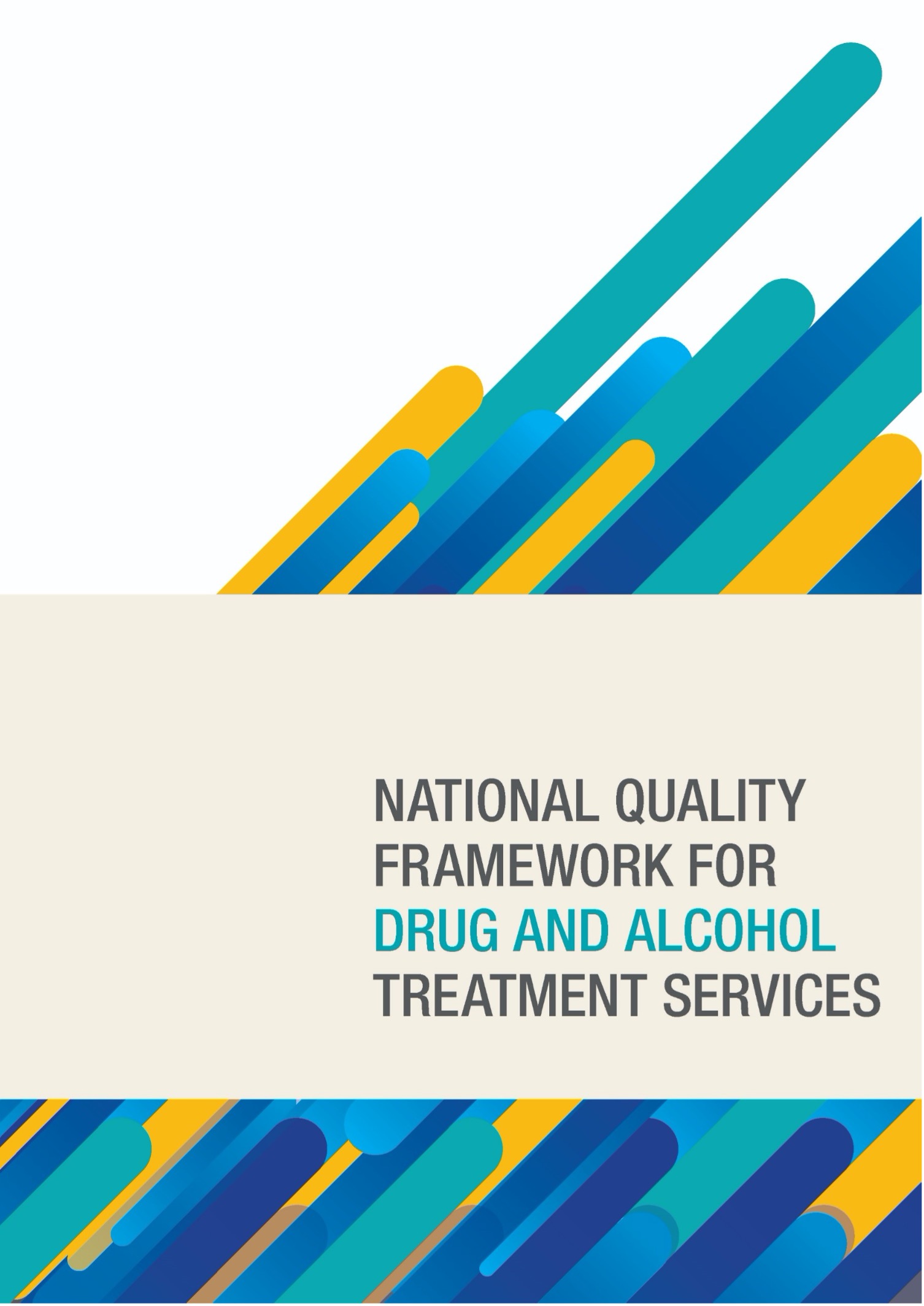When working with clients with alcohol and other drugs (AOD) problems, you will be required to adhere to a number of legal and ethical guidelines that protect vulnerable clients, you and your organisation’s reputation. It is essential that you understand why these guidelines are important so you can follow the spirit, not just the words, of these guidelines.
This topic will cover:
- the clients’ rights under Australian and International law
- contexts and setting of AOD services
- principles for effective AOD treatment
- your responsibilities as a community services worker in the context of AOD service provision
- maintaining work role boundaries.
The overarching aim of the National Framework for Alcohol, Tobacco and Other Drug Treatment is to ensure that: All Australians seeking alcohol, tobacco and other drug treatment are able to access high-quality treatment appropriate to their needs, when and where they need it.National Framework for Alcohol, Tobacco and Other Drug Treatment 2019–2029
The National Framework for Alcohol, Tobacco and Other Drug Treatment 2019–2029 (the Framework) guides Australia’s national response to AOD harm minimisation—focusing on treatment interventions and addressing how harms from alcohol, tobacco, prescribed medications or illicit drugs can be reduced based on individual needs and goals.
The Framework’s aim is to provide a shared understanding and common reference point for:
- Organisations that fund treatment
- Providers and practitioners
- Substance users, their families, friends and significant others.
It also aims to facilitate strategic planning for the treatment services system and gives context to national and state treatment processes, programs and policies.
The Australian alcohol, tobacco and other drug treatment services system has three types of interventions:
- Interventions to reduce harm
- Interventions to screen, assess and coordinate care
- Intensive interventions.
These interventions are delivered in different settings according to the needs of the clientele and community.
Settings include:
- Stand-alone specialist AOD settings
- Primary healthcare settings
- Tertiary healthcare settings
- Other settings where AOD services are provided

AOD services are provided in a variety of contexts and settings, depending on what is appropriate to the individual and community needs, funding availability and industry best practices.
Centre-Based Work
Working in this context means working in a location in the community where there may be a number of services available to meet the different needs of clients experiencing diffculties with AOD and seeking help. Centre-based work supports harm minimisation and early intervention by providing such services and programs as:
Day Programs
Day programs provide clients with support, counselling, education related to AOD and comorbidities, and therapies such as group therapy or art therapy. These programs can be provided to people who are at any stage in the process of recovery, including sobriety, and people who are at risk of relapse.
Drop-In Centres and Recreational Facilities
These kinds of facilities provide safe, drug-free environments in which clients can find support and information, community connections, meals or meal vouchers, and perhaps showers and washing facilities.
They provide information and support in less formal settings and can often be used by clients who are still using rather than just those seeking sobriety or withdrawal programs. These facilities work in the context of harm minimisation and early intervention.
They can provide the first steps to recovery in that they provide an environment that is deliberately welcoming, inclusive, non-judgemental and low-pressure, where people with mental health and trauma issues can begin to feel accepted and build self-esteem.
Recreational services might provide board games, pool tables, basketball, and even meditation and yoga. Drop-in centres can be open outside normal offce hours, often late into the night.
These services are provided to people who are at any stage in the process of recovery, including sobriety, and people who are at risk of relapse.
Housing and Residential Services
Housing and residential services exist in different contexts for clients who have a variety of needs.
Emergency Accommodation
Emergency accommodation is short-term housing provided in emergency situations for people experiencing immediate housing needs. It is considered as an immediate and temporary response to homelessness before clients can transition to other housing options.
Clients who seek emergency accommodation include rough sleepers, women and children escaping domestic violence, and others who are at risk of harm and need a safe place to stay.
Supported Accommodation
Supported accommodation is a medium-term option for clients who are able to live semi-independently. It is usually provided for about 6 to 18 months.
Clients in supported accommodation are usually assigned a case manager who supports them in their recovery and building life skills during their stay. The case manager will also assist clients if they need help managing their mental and physical health or cognitive impairments.
Public and Community Housing
Public and community housing is provided to people who are on low incomes so they can access independent long-term accommodation. Rent prices are usually lower than in the property market or are based on total household income.
Rent Assistance
There may be services available to help clients who are at risk of losing their privately rented accommodation due to loss of income or other issues related to AOD use, or whose tenant rights are violated by their landlord or agents through discriminatory practice.
Inpatient Services
Inpatient services provide medical assistance to hospitalised clients in acute and non-acute AOD need on an elective or emergency basis. This can include planned inpatient withdrawal, unplanned emergent withdrawal, and consultation and liaison with services within general and specialist hospital inpatient units.
Outreach Programs
Outreach programs are provided within the community and may be executed through mobile services run by not-for-profit organisations or non-government agencies. They may take place in public places, such as parks where users are known to gather, festivals, community-organised events, schools, technical and further education (TAFE) or universities, and in other contexts where people with AOD issues may be reached.
Outreach programs provide services within the harm minimisation and early intervention context, and they can provide education and information and access to the internet or phones so that people can talk to service providers or family. More formal and professional services, such as needle and syringe exchange services and sexual health and immunisation services, may also be provided by specialised AOD workers. If this is done in a hospital outpatient context, it can include brief interventions, pharmacotherapy programs, and withdrawal and psychosocial interventions.
Example
4 Voices
4 Voices connects with girls and women who are experiencing, or at risk of experiencing, domestic and family violence, homelessness, social isolation and digital exclusion. Explore the 4 Voice website to find out about how they assist vulnerable women and girls to find social and digital connection and connection to employment and services providers.
Online and Telephone Support Services
Many not-for-profit and non-government organisations provide online and telehealth support for people who are seeking help with their AOD problems. Many people are unable to access face-to-face services for a variety of reasons, and online and telephone support can provide safe, anonymous access to counselling and information.
Support can be provided through texting services, over the phone or VoIP (voice over internet protocol), and through chat rooms or social media.
During the COVID-19 pandemic, the Government realised the importance of providing telehealth options for people in lockdown, and these services have also been a bonus for people with mobility and/or mental health issues who find it hard to access face-to-face services.

The principles for effective AOD treatment are underpinned by respect and understanding the human rights of the individual, and are fundamental to supporting harm reduction and change processes for the individuals who experience problems with AOD and for the community.
There are six treatment principles outlined in the Framework:
1. Person-Centered Treatment
Person-centred treatment is a treatment that is informed by the needs and desires of the client. The treatment should be adapted and adjusted to meet the needs of the client, rather than expecting the client to fit into rigid models of treatment that are unhelpful and even damaging to the individual’s sense of self and autonomy.
2. Equitable and Accessible Treatment
Treatments that are equitable and accessible are able to be accessed by anyone who needs them regardless of race, gender, cultural or religious background, sexuality or identity, or physical or mental ability.
Making treatments accessible and equitable can include providing options for virtual meetings, or holding meetings in buildings or spaces that:
- Are accessible to people who have mobility issues
- Are accessible by public transport
- Are Inexpensive
- Make people who may have suffered defamation, discrimination or violence feel safe.
3. Evidence-Informed Treatment
Treatment programs that are funded under the National Drug Strategy 2017–2026 or other government-funded programs must be informed by current and relevant evidence. For example, programs that might be based on religious beliefs, such as exorcisms or praying over a person, are not based on evidence-informed practices.
Providing cognitive behavioural therapy, medications for underlying conditions such as depression or attention deficit hyperactivity disorder (ADHD), or diversion programs to help young offenders stay out of prison are treatments all based on evidence that has been peer-reviewed and recommended by medical and enforcement authorities.
4. Culturally Responsive Treatment
Culturally responsive treatment options are particularly important if services are to be successful in reducing the harms caused by drugs in communities that are marginalised. Understanding the historical, cultural and religious influences that impact these communities and individuals will help service providers to tailor programs that encourage uptake of the treatment and are more likely to have successful outcomes.
It is important in these contexts for service providers to liaise closely with community leaders, elders, religious leaders and other community members to find out what services they think will be most successful and what will provide the best outcomes for those who access these services.
5. Holistic and Coordinated Treatment
Services that treat clients as whole people with complex needs and complex reasons for their drug problems must consider every aspect of an individual’s health and wellbeing.
Once an individual decides to get sober and clean, they have to learn a whole new way of living. They may need support to access safe and permanent accommodation,job services and income support and to take care of their health. You may work in consultation with a number of professionals to assist a client, including medical doctors, dentists, social workers, community groups and employment services providers.
6. Judgement-, Stigma- and Discrimination-Free Treatment
Many people who have drug problems also have to deal with a lack of self-esteem, which may have been a precursor to drug use or occurred because of their drug use and how others have stigmatised them during their problems. It is important that, when a client comes to service providers, the services made available do not cause further psychological or emotional harm. Services should treat individuals with drug problems as people, not as problems.
Clients will have likely dealt with being treated badly by a number of people: law enforcement, family and even people they pass in the street. They often feel dehumanised by medical and judicial processes and judged by religious institutions. When a client is treated with respect and compassion and as an individual worthy of living their best lives, they are more likely to succeed in their journey to recovery.
Vision and Principles of Practice
The principles of practice underpin all levels of AOD care and service delivery.
| Principle | Practice |
|---|---|
| Principle 1 Service is person-centred |
Services are provided within a trusted, inclusive and respectful culture that values and promotes a beneficial partnership between clients, their significant others and staff. The service respects diversity and is responsive to clients’ needs and values. The experience of clients and their families is reflected in the service system. |
| Principle 2 Services are safe |
Services are continuously improving outcomes by giving regard to the physical, psychosocial and cultural well-being of all clients and minimizing the risk of harm |
| Principle 3 Services are accessible and timely |
The service system is visible, accessible from multiple points of entry, equitable and timely. Clients experience care as welcoming, accepting, non-judgemental and responsive to their needs. |
| Principle 4 Services are effective |
Services are holistic, evidence-based and supported by NSW Health-endorsed standards, policies and guidelines. The service system attends to the diverse medical, psychological and social needs of clients. The continuum of care is integrated across NSW Health, primary care and non-government organisations to reduce fragmentation and optimise outcomes. |
| Principle 5 Services are appropriate |
The service system provides a range of approaches to meet the diverse needs of clients. The experience of clients and their significant others is reflected in the service system. Clients are informed about and engaged in influencing services, treatment and options in a clear and open way. The right evidence-based care is provided by the right providers to the right person, in the right place and at the right time, resulting in optimal quality care. |
| Principle 6 Services use their resources effciently |
Services maximise the use of available resources to deliver sustainable, high-quality care. Services ensure close alignment and integration across services and sectors to avoid duplication or omission of service. |
| Principle 7 Services are delivered by a qualified workforce |
The workforce has the requisite skills, knowledge, values and attitudes to respond to client’s needs, and a capability and willingness to work across disciplines and sectors. |
Watch
Watch ‘What Are the Universal Human Rights? - Benedea Berti’ by TED-Ed on YouTube.
Consider how this relates to the Frameworks you have learnt about.
Reading
The Ottawa Charter for Health Promotion is an international agreement signed at the First International Conference on Health Promotion, by the World Health Organization and held in Ottawa, Canada, in November 1986. Three basic strategies for health promotion were identified: advocate, enable and medicate.
Health Promotion.
In Australian states, the Ottawa Charter is responsible for health promotion initiatives. In New South Wales, areas of action are directly linked to the Ottawa Charter. These action areas include building healthy public policies, creating supportive environments, strengthening community action, developing personal skills and reorientating health services.
Health Promotion Initiatives.

The National Quality Framework for Drug and Alcohol Treatment Services (the Quality Framework) is a statement of quality benchmarks to which AOD treatment services across the country are required to adhere. Its purpose is to realise positive health outcomes for individuals and their families seeking help from services by enhancing the quality and safety of AOD services.
The Quality Framework achieves this by:
- Communicating AOD treatment service quality principles
- Creating a nationally consistent approach to service delivery
- Supporting evidence-based and informed approaches to treatment provision
- Fostering awareness and engagement with consumers about quality treatment services
- Encouraging quality improvement in treatment services.
The Quality Framework is made up of two key components:
- Guiding principles
- Acceptable accreditation standards
Guiding Principles
There are nine agreed guiding principles:
- Organisational governance
- Clinical governance
- Planning and engagement
- Collaboration and partnerships
- Workforce, development and clinical practice
- Information systems
- Compliance
- Continuous improvement
- Health and safety.
Explore
The Quality Framework
Download and read the Quality Framework: National Quality Framework for Drug and Alcohol Treatment Services by the Department of Health
Discuss in the forum, how the nine guiding principles of the Quality Framework work in conjunction with the Framework and the National Drug Strategy 2017–2026.
Reading
Read about the Australian privacy principles: ‘Australian Privacy Principles Quick Reference’ from the Office of the Australian Information Commissioner
In your work within the AOD context, you will encounter many situations where you will have to use your best judgment when dealing with a client’s behaviours. This means balancing the requirement for you to practice duty of care towards your clients and understanding that they have the right to undertake activities you may think put them at risk (dignity of risk).
Case Study
Maria and Josef
Maria is working with Josef, a recovering ice addict. He has been six weeks out of detox and wants to go to his sister’s birthday party on the weekend. Instead of telling Josef that he should not go to the party because there is a risk that he will encounter ice and use again, Maria respects that being able to see family by going to the party is an important part of his recovery.
Maria talks to Josef about ways that he can avoid using, provides positive reinforcement by reviewing techniques he has already learned for coping with social situations, and provides a phone number he can text to get support to not use if he feels tempted.

Many professionals who work with vulnerable people and children have a duty under legislation to report any suspicion of child abuse to the relevant state body. If you do suspect that a child or young person you come into contact with in your AOD work is experiencing child abuse, you should first discuss the situation with your supervisor before taking any action.
Reflection
- What kinds of indicators might you see in a child who has been sexually, physicallyor psychologically/emotionally abused or neglected?
- What kinds of physical indicators might you see?
- What kinds of behaviours might they present?
- What kinds of things might they say?
Any organisation that provides services to minors or to families where minors may come into the service workplace context must have a policy relating to maintaining the safety of those minors while in contact with the service.
Informed Consent
When providing services to a client, you must ensure they understand what they are agreeing to participate in. When a client gives informed consent, it means that they have understood every aspect of the information that you have provided to them about the services they are participating in.

It is vital to your practice, mental health and safety; and the safety of your clients that you maintain firm work role boundaries.
This means maintaining a professional distance from the personal lives of your clients. When working with vulnerable people, you have a duty of care to cause no further harm to those people, and harm can occur if you become too close to an individual in your professional role.
All organisations working in the AOD context will have a code of conduct that you must follow, which will help you to maintain that safety barrier for your own sake and the sake of your clients. This code of conduct will include guidelines such as:
- No gifts are to be given or received by staff
- No money lending
- No staff personal phone numbers should be provided to clients
- No contacting clients or allowing clients to contact you on social media
- No face-to-face socialising with clients
- No gossiping about clients with other clients or staff.
Work Health and Safety
Work health and safety legislation applies to all workplaces, employers, workers and visitors to workplaces.
Duties and Responsibilities
Every employer has a duty of care towards their staff, volunteers and visitors to the workplace. This means they have a responsibility to provide a safe work environment and policies and procedures that protect the health and wellbeing of their workers, visitors, etc. They are also required to provide information and training about safe work practices, and supervisionwhere necessary to protect their workers’ right to a safe and healthy workplace and work practices.
The employer must undertake a risk assessment and harm reduction strategies to ensure that they identify all possible foreseeable risks; and put in place policies, procedures, strategies, education and training to minimise or eliminate the harms that can be caused by these risks. They must consult with their workers about these risks and harms to ensure that all aspects and risks of the job are considered.
Every employee has a duty to work in a manner that does not risk the health and safety of themselves or others in the workplace. This means following any existing workplace policies and procedures to protect themselves, using equipment safely, notifying the employer of any potential risks or incidents that occur, and participating in any training and education that is offered by the workplace to improve health and safety issues.
Volunteers and other visitors to the workplace must follow all instructions they are given regarding health and safety and not do anything that may risk their own health and safety or the health and safety of others. Two key workplace dangers for people working in AOD services are burnout and occupational violence.
Burnout
Burnout is a type of work-related stress in which individuals become physically or emotionally exhausted and feel a sense of reduced accomplishment and a loss of personal identity. Burnout can affect your physical and mental health—it is important to recognise the warning signs so that you can take action to maintain your well-being.
Burnout can result from many factors, such as:
- Lack of control over workload, schedule or work tasks; and also lack of resources to do your job properly
- Unclear job expectations, such as moving goalposts, unclear instructions or expectations, and lack of authority or supervision
- Dysfunctional workplace dynamics, such us bullying, gaslighting, or being undermined or micromanaged
- Extremes of activity, such as monotony; chaotic work schedules, tasks or environments; or having to work at high energy, with short deadlines or in high-stress environments
- Lack of social support, such as feeling isolated at work or in your personal lifeWork–life imbalance when work takes up too much of your time and eats into your personal life and headspace outside of work hours. Spending time with family and friends is important to your mental well-being, and if work reduces this, it can cause burnout quite quickly.
Whatever the cause, job burnout can affect your physical and mental health. Consider how to know if you've got job burnout and what you can do about it. …
Ask yourself:
- Have you become cynical or critical at work?
- Do you drag yourself to work and have trouble getting started?
- Have you become irritable or impatient with co-workers, customers or clients?
- Do you lack the energy to be consistently productive?
- Do you find it hard to concentrate?
- Do you lack satisfaction from your achievements?
- Do you feel disillusioned about your job?
- Are you using food, drugs or alcohol to feel better or to simply not feel?
- Have your sleep habits changed?
- Are you troubled by unexplained headaches, stomach or bowel problems, or other physical complaints?
~ Mayo Clinic
Your employer may provide employee assistance programs or other forms of support. It is important that you talk to someone in your workplace who can help when you are experiencing workplace stressors that can lead to burnout.
Occupational Violence
Occupational violence is a hazard in community services and can have severe and long-lasting impacts on the physical and psychological health of workers.
Occupational violence includes:
- Physical violence
- Sexual assault and harassment
- Verbal abuse, bullying and harassment.
Community services workers may experience incidents of occupational violence from clients, fellow workers, managers and others in the workplace such as family of clients and visitors.
The kinds of occupational violence that may occur in the community services sector can include:
- Physical assault, such as assault with a weapon, hitting, kicking, pushing, grabbing, biting, scratching, or throwing objects
- Witnessing abuse or assault
- Intentionally coughing or spitting on an individual
- Any form of indecent physical contact
- Harassment and intimidating, threatening or aggressive behaviour
- Stalking; sexual harassment; verbal threats; and abuse, yelling and swearing
- Hazing or initiation practices for new or young workers
- Violence from a family or domestic relationship when it occurs in the workplace, including if the person’s workplace is their home.
People who have experienced occupational violence can suffer from short- and long-term physical and psychological injury, including:
- Feeling isolated or disconnected from family, friends and community
- Withdrawal and loss of confidence
- Physical injuries because of assault
- Stress, depression, anxiety and post-traumatic stress disorder (PTSD)
- Illness such as cardiovascular disease, musculoskeletal disorders, immune deficiency, and gastrointestinal disorders as a result of stress
- Depression and other mental health issues
- Suicide.
Explore
Getting Started in the AOD Sector introduces the AOD service system and landscape in Queensland. Much of the information is relevant to practitioners in all states.
Ask your tutor if there is an equivalent document relevant to your state, and if so access and read it.

Legal and ethical considerations are inherently linked but differ significantly. Simply put, legal considerations are based on written law, in contrast to ethical standards that are based upon human rights and wrongs. It is important to note that something can in fact be legal but not ethical.
Ethical and legal considerations:
- harm prevention
- working with at-risk groups
- consent
- privacy and confidentiality
- state and territory legal requirements.
Legislation related to AOD work differs from state to state. The table below provides you with links to further readings.
| Jurisdiction | Legislation |
|---|---|
| Victoria | Severe Substance Dependence Treatment Act 2010 |
| Drugs, Poisons and Controlled Substances Act 1981 | |
| New South Wales | Drug and Alcohol Treatment Act 2007 |
| Drug and Alcohol Treatment Regulation 2017 | |
| Queensland | Drugs Misuse Act 1986 - Queensland Legislation |
| Western Australia | Alcohol and Other Drugs Act 1974 |
| South Australia | Controlled Substances Act 1984 |
| Northern Territory | Aligned with New South Wales and Victoria |
Important
The aims of the Drug and Alcohol Treatment Act 2007 are:
- to provide for the involuntary treatment of persons with a severe substance dependence with the aim of protecting their health and safety
- to facilitate a comprehensive assessment of those persons in relation to their dependency
- to facilitate the stabilisation of those persons through medical treatment, including, for example, medically assisted withdrawal
- to give those persons the opportunity to engage in voluntary treatment and restore their capacity to make decisions about their substance use and personal welfare.
This Act must be interpreted, and every function conferred or imposed by this Act must be performed or exercised so that, as far as practicable:
- involuntary detention and treatment of those persons is a consideration of last resort
- the interests of those persons is paramount in decisions made under this Act
- those persons will receive the best possible treatment in the least restrictive environment that will enable treatment to be effectively given
- any interference with the rights, dignity and self-respect of those persons will be kept to the minimum necessary.
